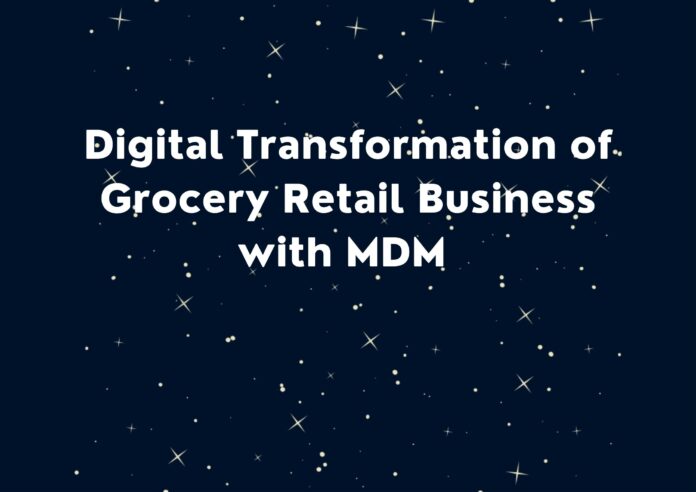Our shopping habits have been changed in this COVID-19 pandemic. It has forced businesses, big or small, to go online. With the entry of online grocers in the market, now there is a demand on how to make the experience better for the consumers when they shop grocery online.
For that, retail grocers need to streamline their data such as products, customers, suppliers, and locations with the help of Master Data Management (MDM).
What Is MDM?
Master Data Management is a tech-enabled program for ensuring that the organization’s shared data i.e. their master data is accurate and consistently updated.
Most organizations use software like CRM or ERP that contain all the important data on customers and the business. This leads to data duplication, rudimentary and redundant data which leads to erroneous decision-making, thus affecting the long-term goals of the company.
MDM helps in streamlining the data meaning that there will be a single data source. A good Master Data management will benefit you in many ways such as improving the data quality, reducing time and cost as it automates the data management process, increased data accuracy, data compliance, and better decision-making.
Benefits Of Digital Transformation in Grocery Retail
The pandemic-induced lockdown has changed the retail landscape. As convenience is critical to attracting customers, the demand for delivery at the doorstep is growing at an unprecedented rate.
In today’s digital world, MDM can become a pillar of marketing, customer service, commerce, and analytics. With the right tools of MDM, retailers can improve productivity and efficiency. This can also help them enter new markets while expanding within the existing ones.
Delivering the right products at the right time at the right place is a common goal shared by all online commerce companies. To make sure that every customer’s needs are met with speed and accuracy can be ensured by MDM.
Hence, digital conversion through MDM can help to modernize workflows and spur digital engagement and conversion.
Here are some benefits of digital experience platform transformation in grocery retail:
- Carry out a rudimentary assessment that helps enable current state findings and requirements capture.
- Understand the existing issues and obstacles in the way of retail success. Build a plan to address those issues.
- Get a deeper understanding of business needs and requirements. Differentiate data that help improve customer experience.
- Gauge the data readiness. Formulate the right strategies for classification and data conversion.
- Define standards, record them, impose them, and abide by them.
- Build an effective governance design that helps strengthen state global governance.
Creating extraordinary customer experiences has become eminent for grocery retailers today. Despite facing several challenges, going digital with the help of MDM will enhance operational efficiency while reducing operating expenses, and will help meet the fluctuating needs of the digital-savvy customer.
Challenges of MDM In the Grocery Retail Industry
To transform grocery store operations, procurement processes, and supply chains, a lot of effort is needed. Companies need to strengthen their offerings while improving pricing, delivery, and promotions. But many hurdles lie in the way which if not addressed quickly can lead to damage in the long run.
Here’s a look at the challenges faced by grocery retailers:
1. Changing demands:
Fluctuating consumer demand is the biggest challenge faced by the grocery retail industry. Health-conscious consumers these days have completely disrupted the grocery retailer’s assumptions. Consumers now advocate only healthy, organic, natural, and vegan food options which force retailers to rely on local produce to meet the modern needs of consumers.
2. Low Margins Threaten Online Success:
Constant price promotions weigh down on returns. Retailers lack data and capability to target promotions on specific consumers making them ineffective and costly to the business.
3. Low cart value:
Carts don’t contain enough high-end products. Consumers who aren’t familiar with online grocery shopping might take time to place their order which leads to a high rate of abandoned carts.
4. Product convenience:
Consumers look for convenience when purchasing any product. This is quite evident in the grocery retail industry where 63% of shoppers upvote convenience as most important. They would easily abandon a brand or a site for another if they cannot get their product delivered on time.
5. Product differentiation:
In a digital world, product differentiation is no joke. Homogeneous products are being offered in different categories. Hence, differentiating them from the competition becomes an enormous task. Therefore, product differentiation strategy becomes important for the company.
6. Safety Regulations:
In this industry, safety regulations have to be met always. Product expiration, the information of ingredients, calories, and allergens needs to be displayed correctly.
7. Rising operational costs:
Running an online grocery retail business entails several costs such as manufacturing, employee salaries, inventory, maintenance, promotions, and more. Online business means additional safety costs of digital payments. Costs increase further when companies depend on legacy systems and manual processes.
8. Increased delivery costs:
Delivery costs are often not compensated by online sales. Retailers don’t charge for delivery for fear of losing customers thus increasing cost pressures and making it difficult for retailers to sustain business as well as maintain profitability.
Two Grocery Retailers That Are Leveraging MDM to Transform Digitally
1. Centralized Product Information Management:
Auchan Retail is French-based and one of the world’s largest retailers. After decades of growth, they amassed an unmanageable difficulty that was affecting their operational efficiency as well as their customer experience.
The grocery chain was keeping the same product in different apps according to different sales channels. This caused several data errors resulting in erratic customer experiences.
Today, the Auchan Retail chain uses an MDM platform to streamline its product information. The unified product data management enables Auchan to share updated and consistent data across all channels.
This online grocer applies a Digital Business Hub strategy that allows them to collect master data from their internal or external source, edit it on their master data platform, and then share the trusted data across, shops, customer loyalty programs, marketing systems, and more.
Using a Digital Business Hub empowers the online grocery retailer to react quickly to constantly changing consumer demands, manage traceability and product returns, provide a compatible customer experience, allowing the customer to trust the online displayed information.
2. Multidomain MDM:
Siplec, part of the French E.Leclerc group leverages a Multidomain MDM solution that creates a single source for their customer, product, and supplier data. The improved master data quality enables the retail chain to create and update new products quickly and also helps in addressing the data issues with ease.
The digital transformation at Siplec, now enabled by streamlining their MDM illustrates its impact tangibly. They can now discontinue legacy systems, custom-built, in-house tools that couldn’t scale with their needs.
Grocery retailers have a much-diversified product assortment with many suppliers, locations, and a diverse set of customers. All this complexity and ever-changing information impact other dependable systems that challenge retailers to keep up as well as provide consistent customer information. Factors that make MDM all the more valuable.
Best Practices For Grocery Digital Transformation
1. Make improvements to your online channel:
Online grocery shopping is still new to some customers. They need a seamless transaction when ordering online.
- Do a thorough evaluation of the items that customers usually buy and make them all available. You can bring the most value to your customers in this way.
- Navigation should be intuitive to help online shoppers easily find what they are looking for.
- Give customers the easiest ways to pay with plenty of choices.
2. Create a strong digital marketing strategy:
Customers know that you offer online grocery shopping. You’d be amazed how little consumers know about what online grocers and in-store grocers do and don’t provide. So, you might have an audience eagerly waiting for your email, posts, messages, and more.
3. Shoppers want the fastest delivery:
One thing the customer doesn’t want to do is to wait for their groceries. For that, the orders must be filled quickly and accurately to gain more customers. Same-day delivery is most preferred. Some grocery retailers are looking for retail innovations which help them to fill online orders as fast as possible. Also, the customers are paying close attention to which stores or brands offer the best online grocery shopping service, like how fast orders can be filled.
4. The Omni-channel approach bridges the gap between in-store and online shopping:
The customers now have access to two different grocery carts; one that they can wheel around the store and the other that exist virtually on electronic devices. It’s likely to feel strange to many of them particularly when using an online grocery cart. For that reason, an Omni-channel strategy is vital.
Concluding With:
The COVID 19 pandemic has completely changed our shopping needs and habits. Now there are more people forced as well as willing to buy online. This changed customer shopping behavior has forced companies to go digital and meet customer needs. Through MDM, grocery retailers are now able to reduce the complexity of data management hence improving the productivity and efficiency of the businesses.











